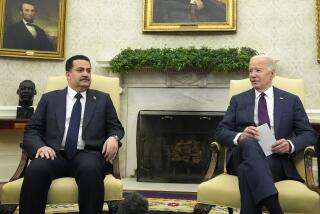Saddam Hussein’s Exalted Image: Every Picture Must Be His
WASHINGTON — So far President Bush is getting high marks for his management of the Persian Gulf confrontation with Saddam Hus sein. Nonetheless, until Iraq abandons its control of Kuwait--unlikely until Hussein is ousted--the President’s credibility will be on the line. If there are military encounters and loss of U.S. lives, Bush will face tough times.
Iraq was part of my turf when I served on the National Security Council staff. To understand the current crisis it is useful to recall how U.S. relations with Iraq evolved. Until recently, Iraq was viewed as a possible partner to work with the United States for a more stable Middle East.
When Hussein invaded Iran in 1980, the United States took a neutral position. U.S. hostages were being held in Tehran and it made sense not further to exacerbate U.S. relations with the Ayatollah Ruhollah Khomeini. Even after the hostages were released, the war was of little concern.
However in 1982 the Iranian army achieved some important victories over Iraq and seemed poised to bring about the collapse of the Iraqi regime.
There was panic throughout the Persian Gulf. If Iraq fell, Khomeini’s armies would be a few hours from Kuwait and the entire region would be at the mercy of a religious fanatic. It was fear of this geopolitical catastrophe that caused the United States to begin its steady tilt toward Iraq. By November, 1984, full diplomatic relations were established. Administration officials had many conversations with Iraqi officials and were hopeful, when the war ended, for a new cooperative era in U.S.-Iraqi relations.
But the war continued for four more years. And U.S.-Iraqi relations suffered a devastating blow with the 1986 disclosure of the Iran-Contra affair--and that the United States had sent weapons to Iran.
From then on, communications were frosty. While the United States continued tacitly to support Iraq by the arms embargo against Iran, video tapes of Iraq’s use of chemical weapons against its Kurdish civilians, and Iraq’s accidental missile strike against a U.S. ship, put Washington on notice. Yet, given the ferocity of the war, Iraq’s behavior could be explained as that of a beleaguered country, fighting for survival.
Then, as suddenly as the war began, it ended in 1988--with a series of stunning Iraqi military victories.
Although there was no love lost for Hussein in Washington, Iraq was viewed as an important Arab country that might serve U.S. interests. This was because Iraq’s closest allies against Iran were Egypt and Jordan--two of America’s closest allies in the region. Iraq had also taken a more moderate position on the Palestinian question. Perhaps Iraq might now become a positive force for peace.
In addition, there were the extraordinary efforts Iraq took after the war to rebuild its damaged regions--hardly the behavior of a belligerent power. On a visit to Basra, in spring, 1988, I was impressed with the sense of mission that most Iraqis expressed about their hopes for the future. In comparison to other Arab countries, Iraq has a literate population, women are integrated into the work force and there is relative religious freedom.
But there was another side of Iraq that made any visitor uneasy: the ever-present pictures of Hussein--he has a personality cult unrivaled anywhere in the world, except possibly in North Korea. He stared from every billboard, shop, restaurant, government office, on buses and carts and every day, without fail, on the front page of all the newspapers.
On this visit I was taken to Baghdad’s art museum to see Impressionist paintings, only to be told I would instead be privileged to see a new exhibit about to open. I was informed that for the past year every artist in Iraq had been urged to paint a portrait of Hussein. I was to see the top 400 selected for showing.
It was amazing. Hussein in every conceivable military uniform--army, navy, air force, commando, jet pilot; in Kurdish costume; as a child, as a teenager and as a young man; with dark glasses, displaying a distinctly Riviera look; at prayer. There was even one painting of Hussein in a tuxedo. I was enthralled by this display of what Malcolm Muggeridge calls “the dungeons of the ego.”
The mistake most people made in misjudging Hussein was to assume that, because Iraq had been through so much suffering and had such high expectations for its future, his illusions of grandeur would be curbed. Kuwait, then, is paying for this mistake.
But could Hussein’s wings have been clipped earlier? I doubt it. Bad as some of his previous deeds were, they were not sufficiently outrageous to galvanize the international community.
That has changed. Like all power maniacs, Hussein has been doomed by his own ambition. It may take time for him to fall, but his advisers must now realize the invasion of Kuwait was a blunder unparalleled in recent Arab history.
When Hussein is gone, Iraq will still be a powerful Middle East country. Its geography, oil, military resources and population assure that. The horrendous impact of demography and economic hardship in most Arab lands will not disappear and resentment of the oil-rich Arabs will not end. The Palestinian problem will again appear at the top of the agenda. Until such fundamental problems are addressed with the urgency now devoted to Hussein, another radical Arab leader will emerge to take his place.
More to Read
Get the L.A. Times Politics newsletter
Deeply reported insights into legislation, politics and policy from Sacramento, Washington and beyond. In your inbox three times per week.
You may occasionally receive promotional content from the Los Angeles Times.










